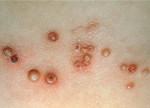 Molluscum contagiosum is a common skin infection caused by a virus. It’s annoying, but not dangerous. Anyone can get it, but it’s most common among children who are 1-10 years old, people who are sexually active, and people who have trouble fighting off infection.
Molluscum contagiosum is a common skin infection caused by a virus. It’s annoying, but not dangerous. Anyone can get it, but it’s most common among children who are 1-10 years old, people who are sexually active, and people who have trouble fighting off infection.
How is molluscum contagiosum spread?
Molluscum contagiosum is passed from one area of the body to another by scratching and from one person to another by direct skin-to-skin contact with an infected person’s bumps or by having contact with an object that has the virus on it. It’s important not to itch or scratch at the lesions to both prevent further spread and prevent secondary bacterial infection.
The virus is spread:
- During any type of skin to skin contact such as sexual activity, contact sports, or other activity that involves touching the bumps of an infected person.
- Through contact with a towel, washcloth or something else that has the virus on it.
- To other parts of an infected person’s body by scratching the bumps.
What are the symptoms of molluscum contagiosum?
Molluscum contagiosum first appears as very small (about 1/8 inch across), smooth, round, pearly bumps. The bumps are hard with a dimple in the middle. They are the color of your flesh, pink, or white, and they are usually no bigger than the size of a pencil eraser. You may see them on or around the pubic area, on the stomach, or inner thighs or anywhere on the body except the palms of your hands or the bottom of your feet. There may be one or two bumps or 10 to 20 or more than 50. Most people have a small group of bumps. The bumps are usually not painful or itchy but they can become red, swollen, uncomfortable and even itchy if they become infected. However, redness and soreness can also mean that they are healing naturally.
Most often the bumps resolve on their own without scarring. However, the most common complication is secondary infection by bacteria. These secondary infections can be particularly problematic for people who are immunocompromised, such as those with HIV/AIDS.
When do the bumps appear?
The symptoms of molluscum contagiosum can appear within 2-6 weeks after coming in contact with the virus.
How is molluscum contagiosum diagnosed?
If you have symptoms of molluscum contagiosum, you should make an appointment with your health care provider who can look at the bumps and make a diagnosis.
How is molluscum contagiosum treated?
Molluscum contagiosum bumps will usually go away on their own, but it may several months. Treatment shortens how long you have them. If you have bumps on your genital area and you’re sexually active, you should be treated to help prevent spreading the virus to your sexual partner(s). Side effects of treatment include: pain, irritation and possible scarring.
Treatment options:
- Freezing the bumps (cryotherapy) or laser therapy by a health care provider
- Scraping the bumps
- Special prescription cream or liquid that is applied directly to the bumps
Is there anything I can do to prevent others from coming in contact with my skin (bumps)?
Yes. It’s important to keep the bumps clean and covered with either a watertight bandage or with clothing if you know you’ll be coming in contact with others (during contact sports or sharing equipment, such as while swimming). This will lower the chance of spreading the molluscum infection to others. Remember: Don’t share personal items such as towels and clothing, don’t pick or scratch your bumps, and be careful not to shave near the bump(s). You may uncover the bandage(s) when there is no risk you will have skin to skin contact with others.
If you think you have molluscum contagiosum, avoid sexual contact until you see your health care provider. With or without treatment the bumps may still take a couple of weeks or longer to disappear. Sometimes the bumps disappear on their own within 6-12 months but it can take up to 4 years. When the bumps go away, you can’t spread the virus anymore. This is because the virus doesn’t stay in your body- it’s gone, but you can get re-infected. Be sure to practice good hand washing.
Source: Read Full Article
